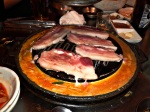Korea has such a wide and varied cuisine, and it would be impossible to cover all the different types of bulgogi, galbi, and jigae in this post, but these are just some of our favorite Korean dishes!
Japchae
What makes japchae so much better than other noodle dishes is the type of noodles used. They are called ‘glass noodles’ or dang myeon and are made from sweet potato starch. The noodles are stir fried with sliced vegetables, like carrots, mushrooms, and spinach, in sesame oil and soy sauce and topped off with a few sesame seeds. Japchae is probably my favorite Korean food so far!
Galbi
Galbi literally means ‘ribs’ in Korean, and is usually beef or pork, although dakgalbi (chicken meat) is also popular. The meat is marinated in soy, garlic, and sugar and is brought to the table raw for you to cook it yourself. In the middle of the table is a grill over hot coals and you cook it barbecue style. Galbi comes with an array of banchan (side dishes) which vary at different restaurants, but they usually include lettuce leaves, garlic, shredded onions, pickled radish, kimchi, and a couple of soups and dipping sauces.
Shabu shabu
 The perfect winter warmer, shabu shabu is Korea’s answer to a Lancashire hot pot. A big, bubbling pot of spicy vegetable soup is placed in the middle of the table over a burner. First round; the meat. Again DIY style, pieces of thinly sliced, semi-frozen beef are thrown into the pot to cook for a few seconds then dipped in a sesame sauce, yum yum! After the meat comes the noodles, which are also put in the soup to cook and soak up the spiciness. Lastly, the soup is poured off into a bowl and fried rice is cooked in the pot, in the remnants of the soup. It is a pretty big meal anjd you have to be really hungry to properly appreciate shabu shabu, but it’s another personal favorite!
The perfect winter warmer, shabu shabu is Korea’s answer to a Lancashire hot pot. A big, bubbling pot of spicy vegetable soup is placed in the middle of the table over a burner. First round; the meat. Again DIY style, pieces of thinly sliced, semi-frozen beef are thrown into the pot to cook for a few seconds then dipped in a sesame sauce, yum yum! After the meat comes the noodles, which are also put in the soup to cook and soak up the spiciness. Lastly, the soup is poured off into a bowl and fried rice is cooked in the pot, in the remnants of the soup. It is a pretty big meal anjd you have to be really hungry to properly appreciate shabu shabu, but it’s another personal favorite!
Gimbap
Gimbap seems to be one of those foods that can be eaten anytime. My co-teachers often have it for breakfast, a snack at lunchtime, or at picnics. It is made from rice (bap), and various fillings like cucmber, pickled radish, squid, spam or cheese, rolled in gim (sheets of dried laver seaweed).
Mandu
 Another street food, and one of Nath’s absolute favorites, mandu are steamed Korean dumplings. They usually have a pork or kimchi filling, and are normally about the size of a tennis ball. They are served with a soy sauce and vinegar dipping sauce. Even if you can’t read Korean, mandu street stalls are instantly recognisable by the huge, steaming vats outside.
Another street food, and one of Nath’s absolute favorites, mandu are steamed Korean dumplings. They usually have a pork or kimchi filling, and are normally about the size of a tennis ball. They are served with a soy sauce and vinegar dipping sauce. Even if you can’t read Korean, mandu street stalls are instantly recognisable by the huge, steaming vats outside.
Tteokbokki
An eternal favourite with Korean schoolchildren, tteokbokki is sold on almost every street corner. In its simplest form it is just bitesize pieces of white rice cake in a red, spicy sauce, although tteokbokki with seafood, noodles, sausage or cheese are also very common.
Samgyeopsal
 Samgyeopsal is fatty pork belly meat, like thick bacon, and is cooked in a similar way to galbi. It is one of the most popular meals in Korea, with apparently 70% of Koreans eating it at least once a week. The name literally means three (sam) layered (gyeop) flesh (sal) and unlike galbi is not seasoned or marinated. Samgyeopsal also comes with a range of banchan including lettuce leaves, perilla leaves, green chilli peppers, garlic, onions and kimchi.
Samgyeopsal is fatty pork belly meat, like thick bacon, and is cooked in a similar way to galbi. It is one of the most popular meals in Korea, with apparently 70% of Koreans eating it at least once a week. The name literally means three (sam) layered (gyeop) flesh (sal) and unlike galbi is not seasoned or marinated. Samgyeopsal also comes with a range of banchan including lettuce leaves, perilla leaves, green chilli peppers, garlic, onions and kimchi.
Chicken and beer
Hardly a traditional dish but fried chicken and beer is hugely popular in Korea, with a chicken ‘hof’ (bar) every few yards. Fried chicken is rarely a meal in itself but is served as a drinking snack (anju) and for this reason is often referred to as chi-maek (chicken and maekju – beer). KFC (Korean fried chicken) can be either with sauce or without, but I prefer it without. Chicken fried in rice instead of wheat flour is also becoming very popular here.
